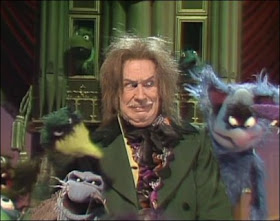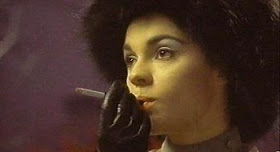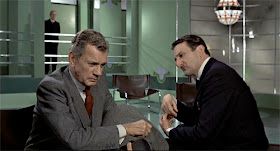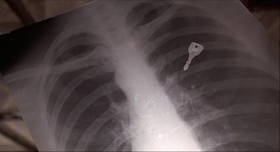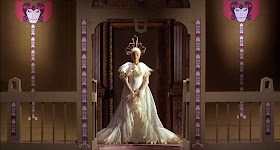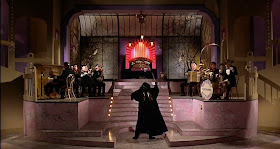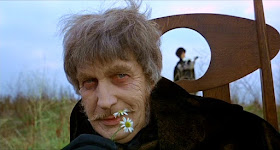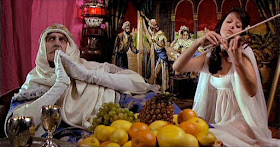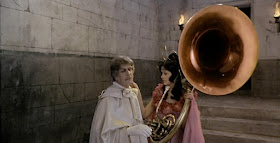Like other genre film connoisseurs whose personal cinema checklists extend back in time well before the latest sparklesome vampires and unasked-for remakes, I hold a certain affection and appreciation for Vincent Price.
That said, I admit that I neglected to commemorate Price's 100th birthday back in May. In recompense, this year's pre-Halloween selection of Octoberfilms will kick off with a handful of his "classics" (small c, scare quotes optional) that I keep on the shelf for precisely this time of year.
Whenever I catch Price in one of his early straight-up dramatic roles, such as in 1944's Laura, I experience a slight, and not altogether unpleasant, cognitive dissonance. Kind of like when seeing, say, Tim "Dr. Frank N. Furter" Curry play William Shakespeare. It's a reminder that Price made a long career as a working actor, a profession uniquely prone to the peculiar vicissitudes of public recognition and typecasting.
After his image-defining roles in horror films such as 1953's House of Wax, 1959's House on Haunted Hill, and Roger Corman's Poe series of the 1960s (alongside his return engagements as the dastardly Egghead on TV's "Batman"), Price and his instantly recognizable silken voice were pigeonholed in camp, swooping-cape villainy. While other actors might fizzle and implode under such stereotyping, he appeared to enjoy his work more than ever before, good-naturedly playing to his pop-culture legacy everywhere from The Muppet Show to Tim Burton's short film Vincent (see below) to Michael Jackson's Thriller.
Did any actor ever have more fun with his public persona than Vincent Price?
 After his 1960s Poe period, he entered his 1970s phase, where his flair for theatrical, ostentatious knavery kicked off the decade with The Abominable Dr. Phibes, a Halloween perennial at our house.
After his 1960s Poe period, he entered his 1970s phase, where his flair for theatrical, ostentatious knavery kicked off the decade with The Abominable Dr. Phibes, a Halloween perennial at our house.Unlike my previous Octoberfilms posts from 2010 — The Innocents, The Haunting, Night of the Demon — this distinctly British entry is a flip black comedy/horror hybrid. It's featherweight fare that's perhaps a touch too satisfied with its own outrageousness.
All the same, if on the "mad killer" horror genre scale you position the (personally repugnant) Saw films as grand opera, then The Abominable Dr. Phibes is Gilbert & Sullivan, and on that scale I'll take Gilbert & Sullivan every time. Here's the kind of perverse humor that Stephen King used to pull off in his more jocular moments. It's the best movie Tales from the Crypt never made.
The Abominable Dr. Phibes was tailored to fit the niche marquee status Price had earned by the '70s, and the film comes off as a self-consciously camp, nostalgic tribute — or pastiche, or fanfic — to Price's pop career. In May '71 it opened in Los Angeles as part of "Hollywood Salutes Vincent Price Week," with American International Pictures playing up Dr. Phibes as Price's 100th film, whether or not it actually was. (The studio had said the same thing about Cry of the Banshee the year before.)
Dr. Phibes unfolds as an old-fashioned Scotland Yard police procedural dolled up in the tradition of the French Grand Guignol: a blend of horrific tale, sentimental tragedy, and farcical comedy.
Before the story begins, Doctor (of Theology) Anton Phibes and his wife were victims of dual tragedies — she of fatal illness; he, rushing to be at his beloved's hospital bedside, of a terrible automobile accident. The beautiful Mrs. Phibes died on the operating table. The good doctor perished in the accident. Or did he? [cue organ music] And if he didn't die, what's left of him? [cue scream sound fx].
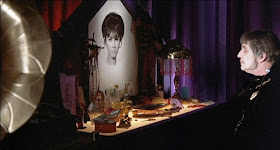 |
| Photos of Phibes' dead wife Victoria are uncredited but were played by eye-appealing B-movie queen Caroline Munro. |
Price, naturally, plays Dr. Phibes — musician, genius inventor, eccentric sophisticate, and obsessively devoted husband who takes "till death do us part" rather seriously indeed. Seeking revenge against the hospital team he blames for his wife's death, Phibes sets out, with Fu Manchu-like resourcefulness, to murder each of them one by one.
The modus operandi behind his vengeance? The Old Testament curses visited upon Pharaoh's Egypt. Phibes dispatches his victims with modern variations of boils, bats, locusts, hail, frogs, and the rest, accessorized with imaginative mechanical contrivances. How he manages to devise each murder according to his rigidly defined motif is part of our pleasure here. One of the victims gets the Plague of Hail treatment in his parked car. How do you kill someone with a "frog" theme? Let's just say there's a costume ball that would do Poe or Ken Russell proud (TCM clip). It all looks like such jolly fun that you may find yourself rooting for Phibes, who, like Hannibal Lecter, really is more clever and more engaging than anyone else in the room.
A great deal of The Abominable Dr. Phibes is spent watching the dundering Yard trying to track down the fiend behind the series of sadistic murders. The common link between the victims — who couldn't be more thinly portrayed if they were rice paper — ultimately points to one Anton Phibes, but according to police records he's long gone so that's impossible, right?
Shaping both Phibes' calculating dementia and Price's performance is the fact that Phibes was horribly disfigured in the car wreck — or else he's a full-on revenant animated by his quest for vengeance and the desire to resurrect his beloved wife; his body was never found, so the question is left open. In either case, like Darth Vader but with a more stylish sense of interior decor, Phibes has augmented himself with period mechanical devices. Unable to speak due to destroyed vocal cords, he communicates by mechanically connecting his larynx to a Victrola gramophone-like device.
Moreover, the waxen, barely mobile face we see Phibes wearing until the final scenes is [spoiler aler— oh, the hell with it] an assemblage of rubbery pieces and wigs he applies as a mask. When the Big Reveal comes near the end he rips off the facade to unveil the skull-like grotesquery underneath (a whole lot like what Price did nearly 20 years earlier in House of Wax).
Pulling off this stunt meant that before the cameras rolled Price had to pre-record Phibes' soliloquies, rants, and Mad Doctor monologues, then physically play to the recordings without actually speaking. Expressing everything facially through heavy makeup (of two radically different types), Price manages to imbue Phibes with a sympathetic nature and macabre charm, even as we're watching him perform his diabolical acts.
"Phibes was something I had to take very seriously when I was doing it so that it would come out funny. All the same, it was just agony for me because my face was covered with plastic, and I giggled and laughed the whole time, day and night, and the makeup man and I were practically married because the makeup kept dissolving and he had to patch me up every five minutes." — Price to a reporter, as quoted at TCM.
Along for the ride are some fine supporting players. Every grandiose archfiend needs an assistant up to the tasks at hand. Here that role is performed by Virginia North as Phibes' mute, mysterious, and murderous companion and ballroom dance partner, Vulnavia. She never says a word and we never learn who she is or where she comes from. Is Phibes' devoted aide-de-camp one of his creations (a Galatea figure) or some spectral Muse of Vengeance who showed up at his mansion when he most needed her? Who/whatever she is, her beautiful yet surreal presence adds a kinky flair to the melodrama without degenerating into a standard-issue sidekick.
And that really is Price's colleague from Orson Welles' Mercury Theatre three decades earlier, Joseph Cotten (Citizen Kane, The Third Man) as chief surgeon Vesalius, the final intended victim. Vesalius' plight — Phibes has kidnapped his son, implanted a key near the boy's heart, and Vesalius must surgically extract the key to unlock his son's bonds before acid rains down on the boy's face — is a "race against time" trap that might have inspired the black-souled Saw series.
 |
| "Work faster, Doctor! The acid is descending! My wife existed only six minutes on the operating table, and then she was dead. You murdered her!" |
The music in Dr. Phibes deserves particular attention: where else are you going to find such sinister machinations carried out to the bouncy vaudevillian strains of "One for My Baby (and One More for the Road)" or "Darktown Strutters Ball" performed by Phibes' personal orchestra of unnerving clockwork mannequins? The film begins with Phibes, his back to us, emoting dramatically on an enormous elevating altar/pipe organ à la the Phantom of the Opera. Last May I attended a university graduation ceremony. The processional music was Mendelssohn's "War March of the Priests," and while hundreds of newly minted grads were filing into the stadium I turned to Elizabeth and asked, "I wonder if they know they're graduating to the opening theme from Dr. Phibes?"
Granted, we're asked to swallow quite a lot of nonsense here — for instance, the skin-lacerating fruit bats (one equipped with a visible "flying" wire), or the notion that distilled brussels sprouts will incite a few dozen locusts to the carnivorous appetites of a school of piranhas. Nonetheless, nitpicking the film is strictly a spoilsport's game. The Brits have always been masters at making a small production budget go a long way, and The Abominable Dr. Phibes is the high-water mark of the English Mad Doctor Gruesome Retribution genre. There's a comic-book cool and cheeky sense of humor that raise The Abominable Dr. Phibes above so many other horror films that play it straight.
 |
| Chief of Police: "A brass unicorn has been catapulted across a London street and impaled an eminent surgeon. Words fail me, gentlemen." |
Enjoyable in a funny-sick sort of way, here's one of the best horror films from the '70s and easily one of Price's most memorable serio-comic outings. While artfully directing his killings one by one, Phibes is clearly having a grand good time. Likewise, one of the things that distinguished Price was that he so often enjoyed what he was doing, and that's evident here. I mean, really now, who else could deliver a line such as "Nine killed her, nine shall die, nine eternities in doom!" and make it work so well?
Spoiler alert, I guess:
The Abominable Dr. Phibes ends with Dr. Vesalius saving his son, then Inspector Trout arriving just in the nick of too late. Vulnavia gets the acid bath and Phibes escapes Trout and the other Yardmen by torching his house and entombing himself with his dead wife, replacing his blood with embalming fluid. His patented Evil Laugh voice-over hints that gears are in motion to guarantee that Dr. Phibes shall rise again.
And sure enough, with a hefty box office profit from the first film, Dr. Phibes Rises Again was rushed into production for 1972. Alas, it's a lesser, lazier work that fails to adequately uptick, or even continue, its predecessor's well-balanced élan.
Here Phibes takes his wife's body in a sarcophagus to Egypt, where a shrine beneath a Pharaoh's tomb grants access to the River of Life that will, Phibes believes, carry him and Victoria to eternal togetherness in the afterlife.
A new batch of ho-hum murders bear an Egyptian motif, and this time a desert-based runaround brings back Inspector Trout along with Robert McQuarry as Phibes' new/old foe, a would-be immortal named Biederbeck. Never mind that Vulnavia was drenched in acid at the end of the first movie, as she's back again. But now she's a different actress (Valli Kemp, Miss Australia 1970) who doesn't possess an ounce of the original's otherworldly presence, so she comes across as little more than a cute sorority girl in dire need of therapy.
Rises Again has a few points of interest — Price gets to deliver lines such as "Nothing can stop me now!" and "So, we meet at last, Biederbeck!", we see Vulnavia in a Pharaoh's tomb holding a tuba for no reason other than it looks so loopy, and the film closes with Price singing "Somewhere Over the Rainbow" as he rafts, Huck Finn-like, down the River of Life, presumably on his way to elysian marital bliss — but otherwise this one's a dreary slog.
A planned third Phibes film never materialized. Several further sequels have been rumored over the years. Right now as I type, the Wikipedia page for Rises Again has a clearinghouse section about the reported sequels. The section isn't satisfactorily sourced, so the usual Wikipedia caveats apply.
The Phibes plot formula did, however, drive a strong follow-up with 1973's Theater of Blood. Again Price plays a presumed-dead madman (in this case self-majestizing Edward Lionheart, a mistreated Shakespearean actor) achieving serial vengeance against his enemies (a well-cast group of eccentric theater critics) through ingenious black-comic contrivances (based on murders in Shakespeare's plays). The Vulnavia character here is Diana Rigg (yes, please) as Lionheart's devoted daughter.
Horror film cognoscenti generally regard Theatre of Blood as the superior picture to The Abominable Dr. Phibes, and it's hard to disagree. Certainly it's near the top of Price's canon and gives him a role that frees him from the make-up restrictions required to play Phibes. Elizabeth and I watched it last night, and for my money The Abominable Dr. Phibes is more fun while Theatre of Blood makes a better bookend to it than does Rises Again.
Music: kexp.org
Near at hand: A 16th-17th-century white clay pipe found while mudlarking along the Thames near London's Rose Theatre archaeological site.




